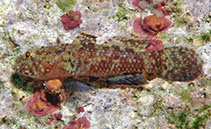| Family: |
Gobiidae (Gobies), subfamily: Gobiinae |
| Max. size: |
4 cm SL (male/unsexed) |
| Environment: |
demersal; marine; depth range 10 - 30 m |
| Distribution: |
Indo-Pacific: northern Java, Moluccas, Marshall Islands, and Samoa (Ref. 1602). Also known from Chagos Archipelago and the Maldives (Ref. 9360). |
| Diagnosis: |
Dorsal spines (total): 7-7; Dorsal soft rays (total): 7-7; Anal spines: 1-1; Anal soft rays: 7-7. Characterized by blotchy brown body color with 3-4 diffuse dark bars on side of body; dark brown fins with rows of pale spots on dorsal fins; completely united pelvic fins with well-developed frenum, reaching nearly to anus; rounded caudal fin; longitudinal scale series 28; cycloid scales on nape, cheek, opercle and anterior to pectoral and pelvic fins, remaining scales ctenoid; predorsal scales 8; opening of gill ending below base of pectoral fin; head with prominent papillae ridges; depth of body 4.8 in SL (Ref. 90102). |
| Biology: |
|
| IUCN Red List Status: |
Least Concern (LC); Date assessed: 14 August 2023 Ref. (130435)
|
| Threat to humans: |
harmless |
Source and more info: www.fishbase.org. For personal, classroom, and other internal use only. Not for publication.
